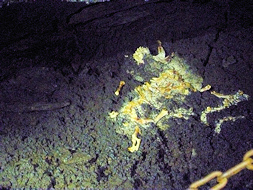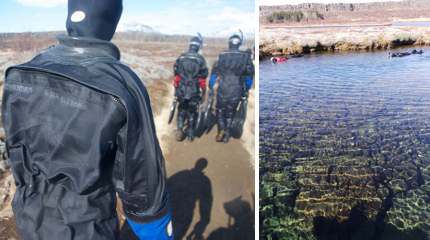Review: Iceland caving and snorkelling tour
Iceland is the ultimate destination for the gung-ho - it's got more than enough glaciers and geysers, mountains and caves to keep even the most daring going. But you don't have to travel far outside the capital to find adventure, as Jane Duru found on a caving and snorkelling tour to plumb the depths of Iceland's natural beauty.
When you first tell people you’re going caving in a lava tube followed by diving in a lake that’s 2°C (36°F), a certain look comes over them. It’s a triumvirate of feelings: at first a knowing, wry smile flits across the lips in relief that they didn’t fall for the joke, swiftly cancelled out by a wide-eyed look of horror as realisation dawns that you’re deadly serious. A final shake of the head in pity is enough to send you on your way.
My boyfriend and I had signed up for the Black and Blue tour led by Arctic Adventures. We’d be spending a morning venturing into the murky depths of the 2,000-year-old Leiðarendi cave, before snorkelling through the glacially cool waters of the Silfra fissure in Thingvallavatn, Iceland’s largest lake.
After being picked up from the hotel in the morning by our guide Robert, we’re soon out on the road, shedding the tiny urban sprawl of Reykjavik for the snow-capped Blue Mountains (Bláfjöll), 30 minutes outside the city. The landscape morphs astonishingly quickly, from cute houses to lumpy moss-covered lava fields. We’re a small motley crew – just us, another young American couple, and a group of wisecracking Icelandic retirees (what do you do if you get lost in a forest in Iceland? Just stand up).
 See strange formations under the lava fields
See strange formations under the lava fieldsWTG / Jane Duru
A few minutes’ walk takes us to an inauspicious snow-covered hole in the ground: the mouth of the cave. It’s here I realise that lava tube means exactly that; with the small opening soon constricting to a tunnel as we descend further into the utter blackness of the cave. The dark is so intense it’s like being swallowed whole. We walk, or rather scuttle, single file, helmet lamps lighting the way, trying to keep a sure footing and our heads from banging the roof. My irrational mind is desperate not to be last one at the back, fearful of suffering that horror movie cliché of being picked off without anyone knowing.
At various intervals, the passage widens out into small chambers and Robert stops to point out the cave’s cool features, like the bulbous stalagmites which formed as molten lava dripped from the roof onto the floor, or the section where the ceiling looks like hundreds of molten bats roosting, and which geologists take as evidence of a second lava flow coming through the cave. The yellowed bones of some poor creature that never found its way out are roped off in one corner. It’s a fascinating tour, although by the end of our 90 minutes my knees feel punctured from crawling through small spaces. The beauty of these caves isn’t in their grandeur, as there are no huge caverns to marvel and gasp at, but it’s still an awe-inspiring experience.
 A gruesome reminder of what happens if you get lost!
A gruesome reminder of what happens if you get lost!WTG / Jane Duru
A short drive later after lunch, we’re at our next stop, to snorkel the fissure at Lake Thingvallavatn in Thingvellir National Park. Turns out, it doesn’t matter what time of year we do the tour, the water only ever reaches a maximum of 3°C (37°F). Fed by runoff from the Lángjökull glacier, it is one of the purest bodies of water in the world, meaning visibility can go up to an incredible 150m (490ft) underwater. Not only that, but the fissure runs between the Eurasia and North America tectonic plates, moving apart by 2cm (0.8 inches) every year meaning you’re essentially swimming between the two continents.
The wind’s really kicking up a storm as we park, and there’s no shelter apart from the van as we get changed into our drysuits. The thermal underlayer makes me impervious to the wind and I feel as cozy as a teddy bear, but once the outer shell, helmet, mask, gloves and flippers are on, I’ve got all the grace of a mermaid on land.
We step into the rift one by one, and the world above disappears in a splash of intense blue. The stillness is intoxicating, as is the clarity; it’s so clear it’s otherworldly. There’s very little marine life, so I spend my time looking at the rocks and wispy algae that surround me, and gazing down into the disappearing depths – the fissure reaches around 30m (100ft) at its deepest point. The colour of the water shifts between a riot of blues: from piercingly intense to gentler greenish hues and then back again. Gently buoyed by the current, we do our circuit, swimming above shallows and underwater canyons, and I'm quickly lulled into a meditative calm.
 With water at only 2°C, drysuits are essential
With water at only 2°C, drysuits are essentialCreative Commons / Francesca Antunes; Arctic Adventures
The one thing distracting me from this watery serenity is the numbing cold seeping into my hands. Whilst the drysuits do an excellent job, the neoprene gloves are barely having an impact, and as advised, I duly attempt to keep my arms folded behind my back in a bid to keep them dry.
We emerge after around an hour, cold and fatigued, but also happy to have experienced such stillness. As if to show off just how cold it is, within 30 seconds of getting out the water droplets on my suit freeze. The ensuing struggle out of suits is rewarded with mugs of watery hot chocolate and a niggling feeling that some reversal has happened; that having explored under Iceland's skin, it might have gotten, just a little, under mine.
IDEAL FOR…
Anyone who wants to get out into the wilderness. The tour difficulty is rated at 2 out of 5, with 5 being the most difficult. Our group comprised a wide range of ages, and whilst a basic level of fitness would be required for the snorkelling, neither activity is too strenuous.
WORTH THE PRICE?
At around £115, it's not cheap, but the experience is unique. The price includes all transfers to and from Reykjavik, lunch, all necessary equipment and a full day's activity.
ROOM FOR IMPROVEMENT
With 8 people in the group, it can get a little crowded in Silfra where some parts of the fissure are only 3m (10ft) across. Swimming single file gets over the problem somewhat, but be prepared for a few jams whilst swimming out.
TIPS:
For caving, wear a good pair of gloves and hiking boots and clothes that you’re happy to scuff and scrape. For snorkelling, wear a woollen base layer (not cotton) that you can keep on under the drysuit.
RATING:
4/5.
DETAILS:
Starting Point: Pick up from Reykjavik hotel.
Times: Daily, with tours starting at 0900 and finishing around 1700. Tours take place all year round.
Price: From £115. Book this tour through World Travel Guide.
Do you have any Feedback about this page?
© 2025 Columbus Travel Media Ltd. All rights reserved. No part of this site may be reproduced without our written permission, click here for information on Columbus Content Solutions.









 You know where
You know where